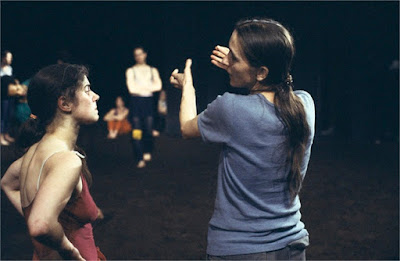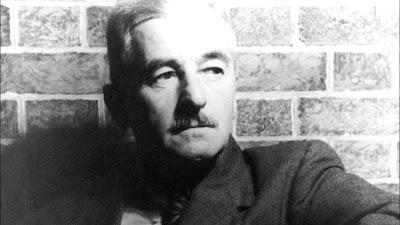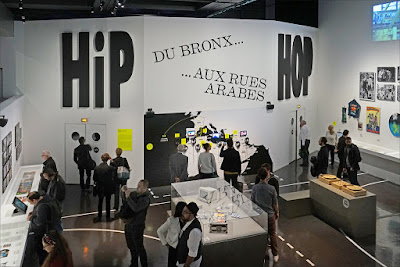
Café Müller (1978) - 1984 Brooklyn Academy of Music
Iphigenia in Tauris (1972)
"... 'Iphigenie,' the choreographer’s second work for her new Wuppertal company, formed just a year earlier, feels, rather touchingly, like the work of a younger [Pina] Bausch. It offers a more or less literal danced depiction of the opera’s libretto, using the 1871 German version based on Euripides’s 'Iphigenia in Tauris.' ... The siblings’ realization of one another’s identity, close to the end of the opera, and as Orestes lies, throat bared to Iphigenie’s dagger, is the dramatic high point of the tale, and Bausch’s piece ends soon after, omitting the more complex ending of the Euripides play. But even in this relatively straightforward, pure-dance account, Bausch’s instinct for the creation of drama through movement alone, and her talent for the conjuring of psychic landscapes and the frightening depthless descent into nightmare, is immediately apparent."
NYT: ‘Iphigenie’ True to Bausch’s Vision
Guardian: Tanztheater Wuppertal Pina Bausch - review
Telegraph: Iphigenie auf Tauris, Tanztheater Wuppertal, Sadler's Wells, review
YouTube: Orfeo y Eurídice visto por Pina Bausch, Iphigenia in Tauris - Pina Bausch, Iphigenia in Tauris
Orpheus and Eurydice (1975)
"The German choreographer Pina Bausch is celebrated (and occasionally denounced) for her epic tragicomic productions, in which her performers speak as much as they dance, offering vignettes of human life and behavior that are absurd, uncomfortable and moving amid strange and powerful stage landscapes. But in Ms. Bausch’s 1975 'Orpheus and Eurydice,' a rarely seen early piece currently being performed by the Paris Opera Ballet, she has created an exquisite work of pure dance that possesses as much theatrical power as any of her better-known later works, perhaps more."
NYT: Two Immortal Lovers Have a Rematch in Paris
culture kiosque
NYT: Squeezing All the Love Out of a Love Story
W - Christoph Willibald Gluck
UbuWeb: Orpheus und Eurydike (1975)
YouTube: Orpheus and Eurydice - Deuil, Piax, Violence
The Seven Deadly Sins (1976)
"The Dance Session is strictly speaking not the session of dance. 'The Seven Deadly Sins' by Kurt Weill and Bertold Brecht and her dance company have come up with the most destructive show one could have ever imagined to see on the German stage. It goes without saying they are doing this quite consciously. This show is not only absolutely unpretentious in terms of scale or humor. It totally lacks any outward luster. This performance is poor, infinitely sad and yet charged with enormous energy… In contrast with Brecht who spoke about seven mortal sins, Pina Bausch focuses on one – renting out female flesh. It is by no means limited to the all too old theme of a woman’s degradation to a sell able pleasure article that can be obtained through fluttery or by force. Neither has it anything to do with emancipation. - Die Welt, June 18, 1976"
"The Seven Deadly Sins" by Kurt Weill and Bertold Brecht
NYT: "The Seven Deadly Sins" and "Don't Be Afraid"
W - The Seven Deadly Sins (ballet chanté)
Come Dance With Me (1977)
"... Come Dance With Me, which features scenes of a woman being pawed by a group of men onstage, may seem tame to an audience inured to the likes of exhibitionist/artist Tracy Emin. But when Bausch’s works were first presented in Europe in the ’70s, they were greeted with slammed doors and thrown fruit. In other quarters, the performances were simply panned, with New York’s Village Voice dismissing them as 'a crock' and The Washington Post more specifically alluding to a 'Teutonic attraction to the powers of darkness, to an alliance of art, disease and malevolence.' Audiences accustomed to Balanchine and Graham were shocked—as were the dancers themselves."
Metropolis
YouTube: Komm tanz mit mir
Blaubart (1977)
1984 - Brooklyn Academy of Music
"A room ringed by women pasted on the the walls like flies, a floor covered with dry leaves that inevitably become entangled in the loose hair of the woman who wallows in them, a chain of mournful figures moving with heads bowed, a scene of repeated physical abuse signaled by the not-so-silent stop-and-start of a tape recorder. These are only a few of the moments - aimed primarily as an assault upon the senses - that flow through Pina Bausch's dance-theater piece 'Bluebeard.' Presented at the Brooklyn Academy of Music Thursday night, this second of three New York premieres by Miss Bausch's company from Wuppertal in West Germany relies more heavily upon a knowledge of German than did her first program."
NY Times
The Violence on the Female Body in Pina Bausch’s Work
Pina Bausch Choreographs Blaubart: A Transgressive or Regressive Act?
YouTube: Blaubart (1977) 1, 2, 3, 4, 5, 6, 7, 8, 9, 10, 11, 12
The Rite of Spring

1984 - Brooklyn Academy of Music
"... A young woman took her place, lying on the ground beside a red scarf. The sound of Stravinsky's 'Rite of Spring' flooded the rotunda. One, two, three women ran in, men joined them, and soon all 32 dancers were on the floor, with signs of effort, concentration and perhaps a hint of puzzlement written across their faces. After 10 minutes, Ms. Bausch waved an arm. The music stopped, and she and her three assistants joined the dancers to dissect the rights and wrongs of what they had just seen. Even after a month of rehearsals, some of the dancers were evidently still struggling to come to terms with the unusual movements associated with Ms. Bausch's vocabulary. Nothing had prepared them for the sudden neck movements, for the sharp bending and turning, even for dancing barefoot. Yet all seemed to consider it a rare privilege to learn from Ms. Bausch, and they exuded a nervous determination to succeed. ..."
NY Times: Using Muscles Classical Ballet Has No Need For
Wikipedia - The Rite of Spring
From the Pet Shop Boys to Pina Bausch | 100 years of The Rite of Spring
YouTube: The Rite of Spring
Kontakthof (1978)
"When it came to the battle of the sexes, Pina Bausch had a shrewd eye. In her trenchant dance-theater works, which gave cause for laughter one moment and a cringe the next, she grasped the tension that lived beneath the skin, the despair that lurked within joy. Bausch died in 2009, just days after learning she had cancer, but her rigorous productions have longevity and a universal reach: They appeal to the spy in us all. In 'Kontakthof,' men and women — anxious with hope and longing — meet in a cheerless dance hall for nearly three hours of romantic encounters. (The title means 'courtyard of contact.') Created in 1978, 'Kontakthof' is vintage Bausch."
NYT: Wallflowers and Lotharios in an Age-Old Courtship Ritual
Guardian
YouTube: Kontakthof, Kontakthof at 65
UbuWeb: Kontakthof mit Senioren ab "65" (2000)
Café Müller (1978)
1984 - Brooklyn Academy of Music
"... There is something allegorical about Miss Bausch's own role in 'Cafe Muller,' which juxtaposes tense dramatic action with five arias from Purcell's 'Fairie Queen.' In an evidently public room (designed by Rolf Borzik), a deserted cafe with scattered tables and chairs, Miss Bausch wanders in a nightgown, with eyes closed. Yet everything about this groping sleepwalker suggests that she is absorbing into her pores every single detail of the emotionally stunted behavior around her - just as she has absorbed the life around her to create her work. The performers are exceptional. Their hallmark is to avoid recognition of each other on stage and as Dominique Mercy and Beatrice Libonati hurl each other against a wall or repeatedly fall out of an embrace, they do so nearly as strangers. Their lips meet but whether they kiss is another matter. When Jean Sasportes crashes through the furniture, he seemingly goes unacknowledged, and his destination is always undefined. When Meryl Tankard's fearful scurries dot the action, she too becomes an unimportant bystander. In Jan Minarik, Miss Bausch - whose background solos serve as an abstraction of the drama - has a powerful perfomer who needs only to stand still to hold the stage."
NY Times: BAUSCH TROUPE MAKES NEW YORK DEBUT
Review: Pina Bausch Wuppertal Tanztheater in Cafe Muller/The Rite of Spring at Sadler's Wells
UbuWeb: Café Müller (1978)
Bandoneon (1980)
"Bandoneon abounds with variations on Miss Bausch's favorite themes. As usual, people are either paralyzed with shyness or goaded by aggression, and love's pains outweigh its pleasures. A bandoneon is an accordion used in Argentine tangos, and the work's recorded accompaniment is a collage of tangos and cafe songs. Just as their rhythms are maddeningly insistent, so Miss Bausch's images grow equally obsessive. What makes the piece special are its references to dance training. Everyone knows that dance classes are demanding. But, at least according to one theory, the joy of accomplishment makes the rigorous training worth enduring. Miss Bausch may not disagree with that theory. Nevertheless, she takes pains -- sometimes literally physical ones -- to show that dancing does not always transcend the woes of the human condition."
NY Times
Laurent Paillier - PhotoShelter
1980 (1980)
1986 - Montreal - Place des Arts
"I performed with the company from 1975 and joined in 1978. The dance world was completely different at that time. There was just one modern dance company in Germany apart from Pina's. Our first audience was theatre people not dance people. We were not moving the way people expected from dance performances but there was a great fascination about the work. People were touched by it. Pina had a kind of authority. I don't know where it came from – it was just there. She never talked loudly, she never screamed, she talked so low that everyone had to be quiet to understand what she said. After the death of her longtime partner and closest collaborator, Rolf Borzik, it took some time for her to decide to work on her next piece, which became 1980. It was a difficult time. All the people involved in its creation tried to entertain and distract Pina. I felt freer to do anything stupid to cheer her up. And then I was surprised that she put many of those things into the final piece. Some people find 1980 hilariously funny; some very melancholic. It depends what you focus on."
Guardian: Performing Pina Bausch's 1980 - in her dancers' words
NYT: Premiere Of '1980, A Pina Bausch'
YouTube: "1980" (excerpt), 1980-(another excerpt)
Nelken (1983)
"Pina Bausch's Tanztheater Wuppertal productions are noted for their stunning, sometimes bizarre imagery, their collage-like sequences, and their pastiche of ritual, dance, text, music, and theatre. Bausch eschews linear story lines, working through juxtaposition and contrast to convey meaning. Much of her work addresses the issue of power in oppressive social structures, the violence between men and women, and the desperate search for love. Receiving its West Coast premiere at UCLA's Royce Hall, her latest work to tour the United States, Nelken ('Carnations'), explores with compassion, darkness, and humor the relationship between individuals, and between individuals and the state. At the opening of the piece, the stage was filled with thousands of pink and white (artificial) carnations, which served as both a backdrop to the performance and an emblem of playful innocence. Dancers entered in evening attire carrying chairs and sat in the midst of the carnations in a sort of bucolic bliss, then walked offstage, chairs in tow. Several male dancers dressed in loose-fitting frocks bounded gleefully through the carnations on all fours. This bunny heaven, however, turned ominous as officials holding leashed German shepherds invaded the perimeter of the stage."
Project MUSE
NY Times: Review/Dance; Pina Bausch's 'Carnations' in U.S. Premiere
ballet-dance
YouTube - The Man I Love (vocal: Sophie Tucker), Dominique Mercy
Viktor (1986)
"The first co-production of Tanztheater Wuppertal Pina Bausch with Teatro Argentina and the City of Rome. As with much of Bausch’s work the imagery in Viktor is brilliantly bizarre and breathtakingly beautiful. The audience is transported through the fragmented action by the human characters who carefully communicate personalities through a few precise gestures or perfectly pitched words. Viktor is accompanied by a combination of symphonic music, folk tunes and music composed for social dancing - from the Middle Ages to the Jazz Age. Even though the work deals with human pain and neurosis, much of it is humorous."
Tanztheater Wuppertal Pina Bausch — Viktor
DanceTabs
Telegraph
Guardian - Tanztheater Wuppertal Pina Bausch: Viktor – review
a studio in covent garden
Sadlers Wells: Viktor
Ahnen (1988)
"The stage is full of enormous cacti. A couple in head-to-toe leopard-skin outfits, cat-ears perched on their heads, wander around with beatific, fixed smiles. Punk-rock music pounds. That music is a tribal beating of drums and a summons to the world of Pina Bausch and her 1987 dance 'Ahnen,' newly revived by her company, the Tanztheater Wuppertal, after a decade-long absence from the repertory. ... But it is also testament to the addictive nature of her oeuvre. Once you have seen a few Bausch pieces, you are likely to have been drawn into a theatrical universe that is like no other — immediately, compellingly familiar, no matter how strange the antics onstage. Wildly different in their particularity, the works are alike in a broader way. All are about love, loss, longing and desire, and the ineradicable human will to survive all."
NY Times
Guardian: Ahnen review – cactuses, cartoon fights and choreography on speed
Ahnen, Tanztheater Wuppertal Pina Bausch, Sadler's Wells
A touch of genius. Pina Bausch and her 'Ahnen'































